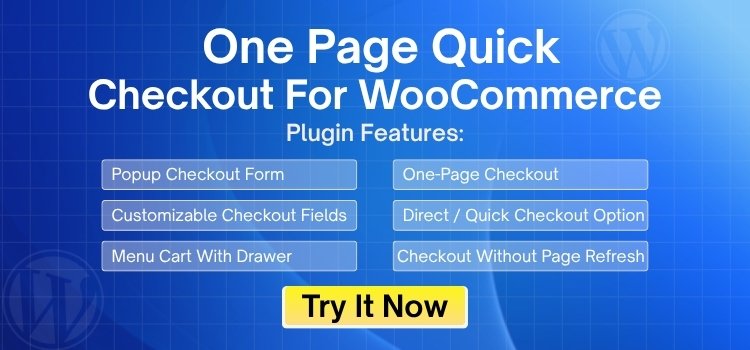Page checkout is one of the most important steps in online shopping because it decides how quickly a customer can finish buying. Many people often wonder about the differences, especially what makes one page checkout faster than multi-step.
The main difference between one-page and multi-step checkout is speed. One-page checkout loads once, reduces server calls, and shows all fields instantly. Multi-step checkout reloads pages, delays validation, and repeats tasks. One-page designs finish faster because they cut page loads, script work, and user friction.
If you are reading about checkout speed, then you are likely interested in knowing how it really affects sales and customer behavior. This article explains the details in a clear way and shows where each method works best. You will find every important point about this topic here.
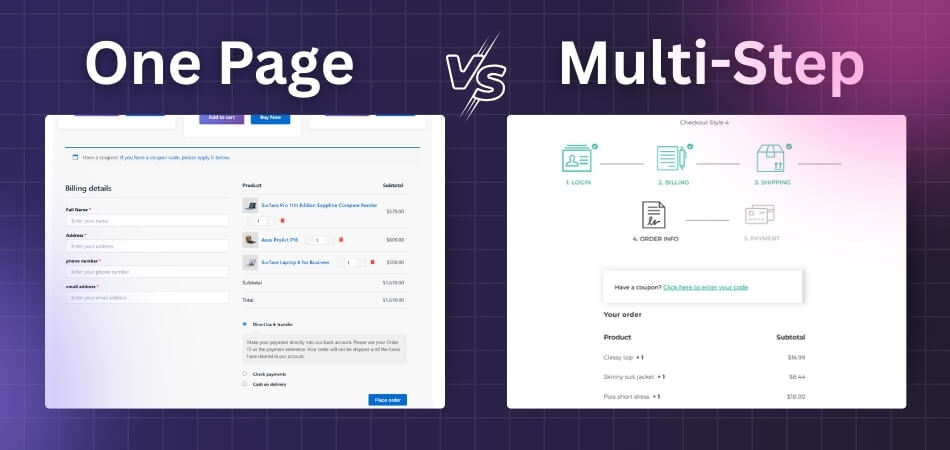
What Makes One-Page Checkout Faster Than Multi-Step?
Online shopping feels simple when checkout is fast and smooth. A long checkout with many steps makes users wait too long. One-page checkout keeps everything in one place with fewer delays. This small change saves time and helps more people finish shopping.
| Area | One page checkout | Multi step checkout |
| Page loads | The whole checkout loads on one page. | Each step loads a new page. |
| Network trips | It makes fewer requests overall. | It sends more requests between steps. |
| JavaScript work | Scripts run once and update parts as needed. | Scripts restart every time a new step loads. |
| AJAX for totals | Totals update in one go with fewer calls. | Totals are updated many times across steps. |
| Server work | The server processes most tasks only once. | The server repeats work at every step. |
| Asset caching | It reuses the same files for the whole process. | It often reloads files at each step. |
| Form validation | Errors show instantly on the same page. | Errors appear after moving to the next step. |
| Payment scripts | Payment code loads only when required. | Payment code loads late, causing a wait. |
| Error recovery | Mistakes can be fixed without leaving the page. | Mistakes force the user to go back and reload. |
| Load speed | It usually finishes in 1.5 to 3 seconds. | It often takes 3 to 5 seconds or more. |
Faster Page Loads
Each extra checkout step makes the browser reload pages and scripts. That creates waiting time and slows down the entire process. A single-page design skips extra reloads and keeps the progress smoother. Customers finish checkout quicker because fewer steps mean less waiting.
Less Script Work
Reloading pages forces the browser to re-run code many times. That includes scripts, event listeners, and checkout logic with added delays. A single-page design avoids repeating tasks by keeping code active. This improves responsiveness and makes checkout feel much smoother overall.
Reduced AJAX Calls
In multi-step checkout, AJAX calls run often for totals and shipping. These calls freeze forms until the server responds back clearly. One-page checkout groups updates together and reduces requests greatly. This method shortens waiting time and speeds up checkout results.
Single Server Load
Every checkout step repeats server tasks like taxes, cart, and shipping. That takes time and uses many unnecessary resources on the server. One-page checkout reduces server work by completing tasks together. This saves time and helps checkout finish much faster overall.
Better Caching
Changing pages during checkout often blocks reusing cached browser files. That happens because each new step may load unique URLs. A single-page approach loads CSS and scripts only once. This keeps assets ready and makes the process finish quicker.
Fewer Layout Shifts
Switching steps may load new widgets, fonts, or third-party scripts. That movement makes the screen shift and slows the page. A one-page design avoids this problem by loading styles early. This keeps everything steady and helps users stay focused.
Instant Validation
Errors often appear only after clicking next in a multi-step process. That wastes time and forces users to wait for a reload. A one-page layout shows error messages directly under each field. This allows quick fixes and reduces frustration during the process.
Smarter Payment Load
Large payment scripts load late in multi-step checkout processes. That creates another delay before users can see payment options. One-page checkout can load scripts earlier or on field focus. This way, payment is faster and users wait much less.
Fewer Distractions
Extra checkout steps often add chats, ads, and third-party scripts. These increase requests and slow down the main checkout thread. Many stores find that One Page Checkout for Woocommerce makes everything smoother. This design makes checkout faster and gives users a simpler experience.
Clearer Process
Clicking next, waiting for spinners, and loading layouts creates friction. These constant breaks make checkout feel longer and more tiring. One-page checkout keeps everything in one clear and simple view. Customers stay focused and finish faster without unnecessary distractions.
One-page checkout is faster because it removes wasteful extra steps. Every saved second improves the chance of finishing checkout without frustration. Less loading, fewer scripts, and faster response times really matter. A simpler checkout process usually helps both shoppers and businesses equally.
Why Loading Times Differ Between One Page and Multi-Step Checkouts?
Loading times during checkout can feel very different depending on how the process is set up. Sometimes everything seems smooth on a single page, while other times the process slows down as you click through several steps. Let’s explore why this happens in detail.
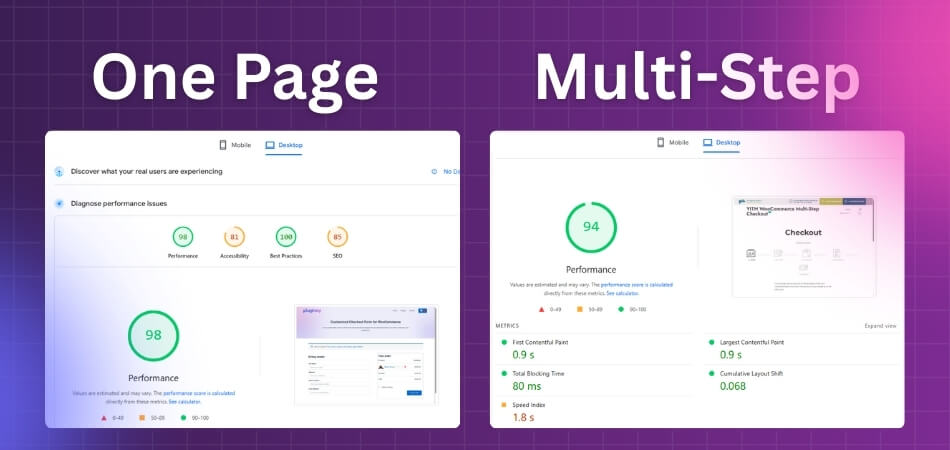
Page Loading Style
In a one-page checkout, all elements like forms, scripts, and product details are loaded at once. This makes the whole process ready upfront. In multi-step checkouts, every step reloads scripts and data, which increases loading time and slows the process.
Server Requests
One-page checkout sends fewer requests to the server because it loads everything in one go. Multi-step checkout creates several requests at each step, which increases the time it takes to process and deliver the needed data back to the user.
User Experience
A single-page checkout feels faster since all details are shown at once. Multi-step checkout can feel slower because users need to wait for each page to load. The experience is shaped by how often pages refresh during the process.
Script Reloading
Every step in a multi-step checkout triggers scripts and validations again. This can delay progress. A one-page system reduces this repetition because scripts run only once. Tools for testing WooCommerce checkout often reveal that one-page setups load faster since they don’t require multiple reloads like multi-step checkouts.
Network Impact
Internet speed plays a role, but page structure matters more. A heavy one-page checkout may take longer initially, but it saves time later. Multi-step pages may seem lighter at first, yet the repeated reloading increases the total time to complete the checkout.
Both checkout styles have their own advantages, but loading times mainly differ because of how many times data and scripts need to reload. Understanding this helps businesses choose the right style to improve the shopping experience.
How Does Checkout Flow Impact Cart Abandonment Rates?
The checkout flow plays a big role in online shopping success. A smooth process keeps customers happy and willing to buy without delay. When it feels slow or hard, many people leave their carts. The way checkout is designed can change sales numbers fast. Here is how your checkout flow affects cart abandonment:
Fewer Steps
Customers feel comfortable when everything happens quickly on one page. They do not want to click through many steps during checkout. A long process makes people lose interest and quit early. One-page designs make finishing the order easier and much faster.
More Trust
A simple process helps people feel safer when entering their details. They trust a website more when the checkout is smooth and clear. If forms are long, they may leave without buying anything. Customers finish more purchases when checkout feels simple and friendly.
Mobile Ease
Phones are often slower and smaller, so extra steps annoy buyers. A single page works better because it loads faster and saves time. People enjoy an easy screen with fewer actions before the final payment. Shopping feels smoother when fewer clicks are needed on phones.
Clear Design
Good design is important because clutter can confuse and frustrate users. A checkout that feels too busy can make people stop midway. Multi-step checkouts sometimes help by splitting tasks into smaller, easier parts. What matters most is making things clear and simple for everyone.
A good checkout makes shopping easy and keeps customers happy longer. Bad design increases abandoned carts and lowers trust in online stores. When checkout is quick, people finish their orders with fewer doubts. Clear design with fewer steps helps businesses earn more sales.
Best Practices for Optimizing Any WooCommerce Checkout Flow
Making the checkout process simple and fast helps people finish purchases. A slow or confusing checkout can make users leave without buying anything. Improving the flow is not hard when you know the right steps. Keep reading to learn the best practices today.
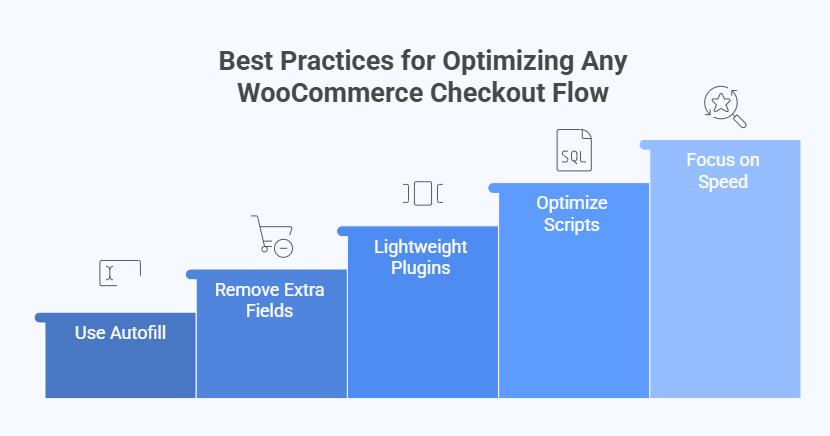
Use Autofill
Filling out the same details again and again slows things down. Autofill lets customers complete important fields instantly without typing everything. This makes checkout feel smooth and less tiring for users. Always enable autofill so people can finish the process quickly and easily.
Remove Extra Fields
Too many fields in checkout often confuse and frustrate customers badly. Unnecessary fields also add more time before the order is done. Keep only the details that are required to finish the purchase. A shorter form increases the chances of a quick and successful checkout.
Lightweight Plugins
Heavy plugins can slow down the site and cause delays. Using lightweight plugins makes checkout faster and more reliable for customers. They help keep pages loading quickly without extra tasks slowing things down. Always review plugins and remove those that are not really needed.
Optimize Scripts
Checkout pages often load extra scripts that are not important. These scripts take time and make the process feel longer. Optimize the scripts so only the needed ones run during checkout. This keeps the process fast and reduces unnecessary waiting times.
Focus on Speed
A slow checkout page can lead to higher abandonment rates online. Speed matters for both user experience and overall website performance. Beyond conversions, one overlooked advantage is the SEO benefits of fast checkout, since search engines factor site speed into rankings. This makes optimization very important.
Improving the checkout flow is about keeping things simple and fast. Every change that reduces steps or speeds up the page helps. Customers are more likely to finish when the process feels easy. A smooth checkout experience benefits both the store and its users.
When Multi-Step Checkout May Still Be the Better Choice?
Not every store needs a one-page checkout to succeed with sales. Some situations work better when the checkout is longer but more organized. It depends on the kind of products or rules involved. Let’s look at when multi-step checkout makes more sense.
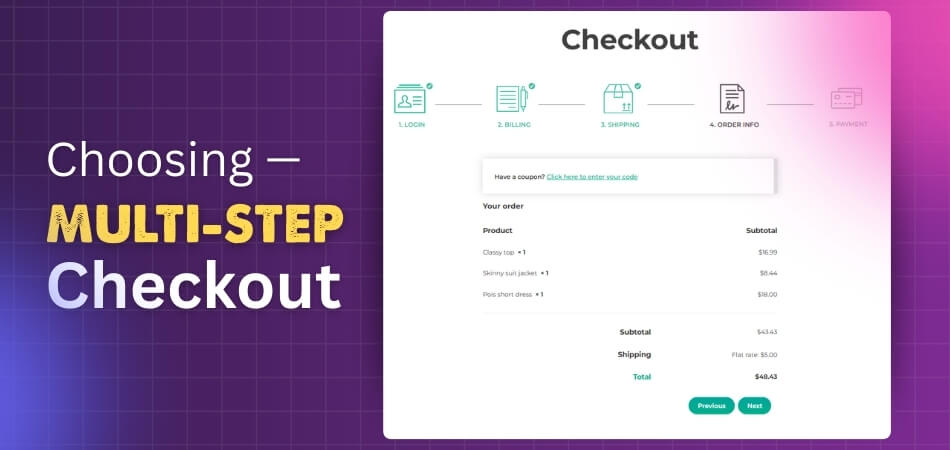
Complex Orders
When a business sells products that require many details, extra steps help. Breaking information into smaller parts makes it easier to understand. Customers can focus on one section at a time without confusion. This structure helps avoid mistakes in long or complex forms.
B2B Purchases
Business-to-business orders often include bulk products or unique services. These orders may need detailed billing, shipping, and contract information filled in carefully. A multi-step process organizes these fields more clearly for businesses. It helps companies complete their large or special orders without problems.
Legal Requirements
Some industries require collecting extra information for tax or law compliance. A multi-step checkout makes space to display required notices and agreements. Customers can review the rules step by step without missing anything. This helps businesses follow legal standards while keeping users informed.
High Customization
Products that allow custom choices can make checkout longer by design. Breaking the process into steps helps guide customers through each option. This prevents them from feeling overwhelmed with too many fields. Structured steps give them time to select everything properly.
Extra Security
In cases where high-value items are sold, security becomes very important. Multi-step checkout allows extra verification steps without crowding one page. Each step can confirm identity, payment, or shipping details carefully. This gives customers more confidence in the safety of their purchase.
Multi-step checkout is not always the fastest option available online. But for special cases like business orders or legal needs, it works better. The structured flow can make complicated tasks more organized. Sometimes, clarity and compliance matter more than speed in checkout.
FAQs About What Makes One Page Checkout Faster Than Multi-Step?
Many people wonder why one-page checkout feels faster than multi-step checkout. The answers are not always clear unless we look at common questions. These FAQs explain the simple reasons behind speed differences in checkout design. Each answer is written to give an easy and complete understanding.
Why Do Shoppers Prefer Quick Checkout?
People prefer fast checkout because it saves their time and energy. No one enjoys waiting too long when they are ready to buy. A smooth process makes them trust the store more and feel happy. Quick checkout also reduces frustration and increases the chance of purchase.
How Does Browser Speed Affect Checkout?
The speed of the browser can make checkout faster or slower. A one-page checkout benefits more because it loads fewer new pages. When fewer reloads happen, browsers handle the work more efficiently. This makes the overall checkout feel much quicker for users.
Why Is Simplicity Important in Checkout?
A simple checkout makes the process easier for everyone involved. When steps are too complicated, customers get confused and annoyed. One-page checkout is simple because everything appears together on one screen. This saves time and lowers the chance of people leaving early.
Can One-Page Checkout Handle Large Orders?
Yes, one-page checkout can handle large orders if designed correctly. It just needs a clear layout that organizes many details well. When fields are grouped smartly, even big orders finish without issues. This proves one-page checkout works for simple and complex needs.
How Does User Focus Improve Speed?
When everything appears on one screen, users stay more focused. They do not get distracted by extra pages or loading breaks. This helps them complete checkout faster without losing their place. A clear and steady view keeps them moving forward without delays.
Why Do Errors Slow Down Multi-Step Checkout?
Errors slow multi-step checkout because people must reload and go back. Each new page makes them wait before fixing the mistake completely. On one-page checkout, errors show instantly under the same field. This quick feedback saves time and makes users finish checkout faster.
Does One-Page Checkout Help First-Time Shoppers?
First-time shoppers often worry about complicated processes online. A single page makes it easier since they see everything clearly up front. They do not need to figure out which step comes next. This comfort makes them more likely to complete their first order.
Final Words
A checkout process should always feel easy and smooth because it affects sales directly. Both one-page and multi-step methods have their own value depending on business needs. The key is understanding which approach helps customers finish shopping quickly without confusion.
The real difference comes down to what makes one page checkout faster than multi-step, and the answer is simple. One-page cuts extra page loads, reduces repeated work, lowers requests, and keeps everything in one view, making the checkout smoother and much faster.
To end, focus on making checkout pages light, reducing fields, and improving speed. Test often to keep everything working smoothly for all devices. Best wishes to you as you create a checkout flow that truly helps customers.
